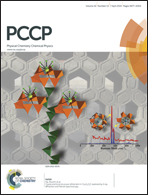A theoretical study of the ozonolysis of C60: primary ozonide formation, dissociation, and multiple ozone additions†
Abstract
We present an investigation of the reaction of ozone with C60 fullerene using electronic structure methods. Motivated by recent experiments of ozone exposure to a C60 film, we have characterized stationary points in the potential energy surface for the reactions of O3 with C60 that include both the formation of primary ozonide and subsequent dissociation reactions of this intermediate that lead to C–C bond cleavage. We have also investigated the addition of multiple O3 molecules to the C60 cage to explore potential reaction pathways under the high ozone flux conditions used in recent experiments. The lowest-energy product of the reaction of a single ozone molecule with C60 that results in C–C bond breakage corresponds to an open-cage C60O3 structure that contains ester and ketone moieties at the seam. This open-cage product is of much lower energy than the C60O + O2 products identified in prior work, and it is consistent with IR experimental spectra. Subsequent reaction of the open-cage C60O3 product with a second ozone molecule opens a low-energy reaction pathway that results in cage degradation via the loss of a CO2 molecule. Our calculations also reveal that, while full ozonation of all bonds between hexagons in C60 is unlikely even under high ozone concentration, the addition of a few ozone molecules to the C60 cage is favorable at room temperature.


 Please wait while we load your content...
Please wait while we load your content...